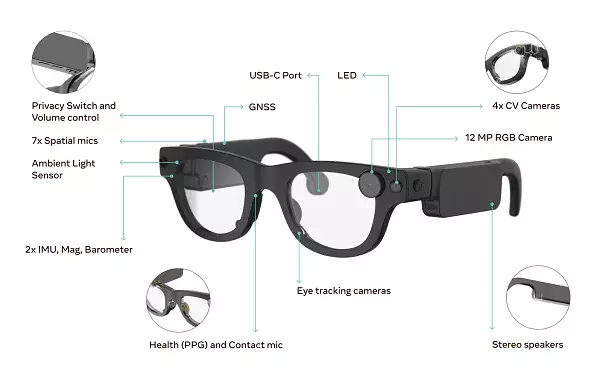Meta’s foray into augmented reality (AR) technology is not just another tech innovation; it is a significant leap into a future where digital and physical realities intertwine seamlessly. The anticipation surrounding Meta’s upcoming AR glasses, specifically the second-generation model dubbed “Aria Gen 2,” speaks volumes about our collective desire for more immersive digital experiences. The quest for lightweight, fashionable, and affordable AR solutions is only one facet of what makes these glasses a game-changer. By focusing on design, performance, and user practicality, Meta is gearing up to redefine how we interact with digital content in our daily lives.
Design Meets Functionality
The design elements of Aria Gen 2 signal a keen understanding of user needs and preferences. Weighing between 74 and 76 grams, these glasses manage to strike a balance between being lightweight and incorporating sophisticated technology. The introduction of folding arms not only adds to their practicality—from easy storage solutions to carrying convenience—but also symbolizes a forward-thinking design philosophy that prioritizes user experience. It’s evident that Meta is seriously contemplating what it means for technology to blend into our lives rather than stand out as a cumbersome accessory.
Moreover, seven different size variations are set to accommodate various face shapes and sizes, a nod to the individuality of users. This attention to detail reflects a deeper understanding of ergonomics in tech design, acknowledging that discomfort can severely detract from user experience. The emphasis on comfort and fit indicates that Meta is not merely interested in delivering a device; it aims to foster genuine user engagement, making AR a natural extension of ourselves.
Pushing Boundaries with Advanced Sensors
The technological enhancements in Aria Gen 2 extend beyond mere aesthetics. Meta has equipped these glasses with advanced camera sensors capable of operating in diverse lighting conditions—an absolute necessity for practical AR applications. The expanded field of view sets a new standard; users can expect more immersive experiences, facilitating a deeper interaction with the digital overlay on their physical surroundings.
Furthermore, the incorporation of a contact microphone embedded in the nose pad speaks volumes about Meta’s commitment to optimizing audio capture in noisy environments—an oft-overlooked aspect in AR device design. With this feature, the glasses can not only capture sound effectively but respond intelligently to user interactions, amplifying the potential use cases significantly.
Redefining Human-Computer Interaction
As Mark Zuckerberg has referred to functional connected glasses as the “holy grail” of tech, the implications of their widespread adoption are far-reaching. Envision a time when smartphones are relegated to the background, and users engage in natural conversations with their AR glasses instead. This transition could revolutionize communication, allowing for a more seamless integration where digital experiences become the norm rather than exceptions.
In a way, this evolution perhaps feels daunting. Imagine walking through a park and observing individuals gesturing animatedly at invisible interfaces, their movements a blend of familiarity and peculiarity. While such visions may seem odd today, history has shown that technology often marginalizes the unconventional before ushering it into daily life. The capabilities that AR glasses bring could redefine connectivity, enabling people to engage with the digital world in an entirely new fashion.
Opening Doors for External Collaboration
Meta’s plan to invite external developers to innovate on the Aria Gen 2 framework later this year is a strategic move that goes beyond product marketing—it’s about building a thriving ecosystem. By democratizing access and encouraging external contributions, Meta is fostering a community of creativity that will accelerate the development of AR applications.
This initiative not only entices developers to explore novel ways to utilize AR but also positions Meta as a forerunner in the AR space. The impending consumer launch anticipated in 2027 may mirror the app explosion that smartphones experienced—an era of unbounded creativity and social engagement fostered by augmented reality.
With Aria Gen 2, Meta is not simply introducing a new product; it is laying the groundwork for a transformative chapter in augmented reality. The design choices, technological advancements, and community-driven development signal a meaningful step toward a future in which our realities may blend seamlessly with digital enhancements. The future is vividly clear: AR is not just an accessory; it may soon become an essential thread in the fabric of our daily interactions.

